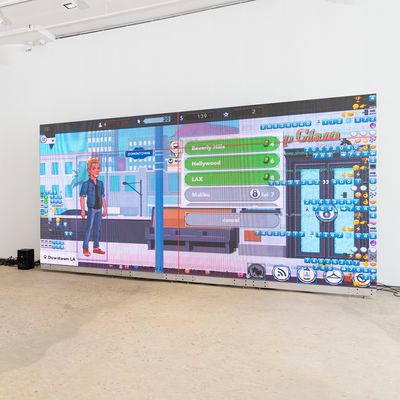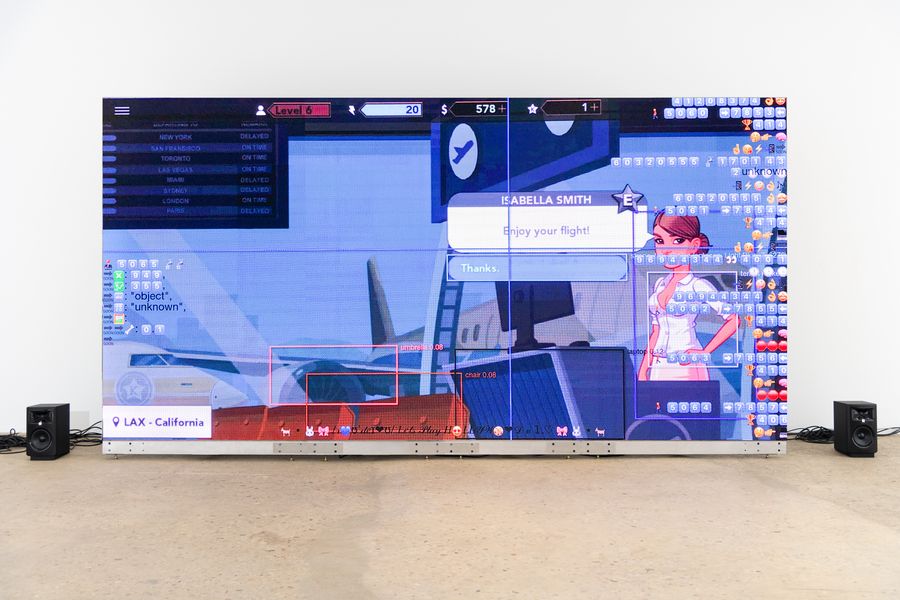
Money and fame, by any means necessary, has always been Kim Kardashian West’s aim. Over time, her brand-savviness and amassed wealth have earned her the respect of at least some of the “right” people; she now regularly graces the pages of magazines like Forbes and Vogue as an entrepreneur, criminal-justice reformer, and billionaire shapewear creator, rather than a chronically attention-seeking reality star. But Kim can never really outgrow some of the ventures that got her there. Before she had her own brand, Skims, she stumped for Charmin (the toilet paper), Skechers Shape-Ups (including a Super Bowl spot), and Carl’s Jr. salads (“While the best things in life are messy, it’s fun to get clean”). Among her iconic lowbrow mid-career ventures: the smartphone game Kim Kardashian: Hollywood.
Launched in 2014, the entire point of the game is for players to garner as much money and fame as possible. In real life, the game did actually make Kim a solid chunk of change. She once claimed to have cashed an $80 million check from Kim Kardashian: Hollywood alone, though Forbes estimated that figure was probably closer to $20 million. (Lindsey Weber, writing for Vulture in 2014, called the game “better than it has any right to be.”)
Now, nearly seven years and tens of millions in residual checks later, Kim Kardashian: Hollywood is getting the white-cube treatment: It’s the primary material for artist Cory Arcangel’s show “Century 21,” on view at the Chelsea gallery Greene Naftali, until April 17. And in a way, this is exactly how the game was always meant to be played.
Arcangel is known for his technological interventions that wink at the absurdity of the digital age. The 42-year-old artist, who’s now based between Brooklyn and Norway, had his breakout with his 2002 “game modifications,” a series of works for which he hacked classic Nintendo games like Super Mario Brothers and Hogan’s Alley to create something entirely new. In the case of Super Mario, he removed all elements except for the scrolling clouds; with his Hogan’s Alley “mod,” he replaced gangster characters with Andy Warhol. In 2011, Arcangel became one of the youngest artists ever to have a solo show at the Whitney Museum. “Cory Arcangel: Pro Tools” also featured a major video-game work, Various Self Playing Bowling Games (aka Beat the Champ). For the piece, he hacked bowling video games to create an infinite loop of gutter balls. He told the Brooklyn Rail at the time that the working title of the piece had been The Failure of Western Civilization, and that his goal was to create a “humiliating, mind-numbing experience” that was both funny and awkward.
A decade later, Arcangel’s more recent algorithm-oriented work feels like a natural successor to his other video-game interventions. Arcangel’s Greene Naftali show includes his installation /roʊˈdeɪoʊ/ Let’s Play: HOLLYWOOD, which allows us to watch as a bot attempts to play Kim Kardashian: Hollywood. In contrast to his earlier work, the code of the game itself has not been altered. As Arcangel himself put it, he is “no longer the author of the narrative … In that sense it’s like having an animal in a work or a performance in the gallery.”
The work takes up most of the first room you enter in the gallery: An 8-by-16-and-half-foot-tall monitor shows the feed from a computer running, as the bot’s website explains, a “Deep-Q machine learning super computing system.” (It’s souped up with a heavy-duty processor and other equipment beloved by hard-core gamers that a gallery assistant described as a “Twitch flex”; it’s almost definitely the first time this gear has been used to play Kim Kardashian: Hollywood.) The area where the computer sits is staged like a workspace, complete with what appears to be a commemorative mouse pad featuring a still from Various Self Playing Bowling Games. Each time the machine-learning bot, which Arcangel named /roʊˈdeɪoʊ/ (pronounced like the “Rodeo” in “Rodeo Drive”) recognizes an image onscreen, it decides whether to click or make a gameplay move. Crosshairs represent the “mouse”; a “click” noise that sounds a little bit like a guitar strumming comes out of a speaker nearby. (The sounds were designed by Daniel Lopatin, who performs under the name Oneohtrix Point Never.)
I dropped in on a bad day for the poor bot: Its avatar in the game, a blonde guy with a goatee, was shown stuck at a bus stop in downtown L.A. (The game lets you design your own avatar; one looks a little like Arcangel.) You need cash to use transportation in the game, while another currency called stars can be used to purchase condos, furnishings, pets, and favor with other people — it’s Kim Kardashian’s Hollywood, after all. The bot had only $2 to his name when I walked in, and $3 when I walked out over an hour later. Every time the bot tried to click into one of the prompted game moves — such as getting on the bus, adopting a stray cat named Charli, or confronting your character’s nemesis, Dirk Diamonds, at “Mirimount Pictures” — a pop-up would inform the player it didn’t have enough cash. Often, the bot would be prompted to watch a free ad to gain stars. And when the bot watches an ad, you, the gallery-goer, watches an ad, too, for everything from Rock & Roll Denim to Walden University.
After watching this loop for a while, I was ready to scream — ready to grab the computer’s mouse and take over. There’s a reason why the computer station’s plinth is bounded by one of those little gallery stanchions: look, but do not touch. In nearly an hour of watching the game, I saw Kim’s avatar only twice, both times because the bot had quit out and restarted gameplay, prompting an intro screen which displays a cartoon version of her face. In that regard, the whole experience scored for realism: If you really were a guy at a bus stop with $2 left in your pocket, you probably would not interact with Kim Kardashian unless you saw her likeness on a billboard or advertisement.
The other works in the show are supporting characters to /roʊˈdeɪoʊ/ Let’s Play: HOLLYWOOD, but are also more obviously funny. There is a group of what you might call works on paper: a series of airplane vomit bags on which Arcangel has printed “now let’s be clear” and “I don’t know who needs to know this” and other phrases that often precede a scolding Twitter thread. Two other bot-related works are also on view: one with multiple monitors that shows a bot automatically liking corporate tweets, and one in which two bots play chess against each other by posting Instagram comments. There are also a few of Arcangel’s so-called “flatware” works, Ikea tabletops affixed with prints showing close-ups of the logos on track pants. These pieces seem to justify /roʊˈdeɪoʊ/ Let’s Play: HOLLYWOOD’s existence in a gallery by showing that Arcangel does work in other media, throwing viewers a bone with tangible objects that are easier to understand as art. The humor of those objects also gives context to his Kardashian-based opus: It confirms that Arcangel is making a joke, and that he’s also making a point. As he once said of his works, “They seem like a joke at first, but it’s never what they are. If you look at them they’re always a little bit more complicated.”
/roʊˈdeɪoʊ/ Let’s Play: HOLLYWOOD certainly says a lot about the specific nature of Kardashian’s fame. While her ascent may seem undeserved to many observers, she made it happen through a series of strategic tabloid story placements and product deals. The bot playing the game “at random” stands in stark contrast to the not-at-all-random nature of Kim’s campaign of self-promotion, and also to the aim of the game itself: to execute a series of carefully calculated moves in order to get famous.
Kim’s savvy as a businesswoman is clearly not enough to stop her from being the butt of the joke when it comes to the art world. Her soon-to-be-ex-husband, Kanye West, has had more success at the crossover: He studied painting, he’s commissioned artists such as George Condo and Takashi Murakami to create his album covers, and he even staged his own solo show at a blue-chip L.A. gallery in 2016 (aptly titled FAMOUS). Not to mention the Calabasas estate that he and Kim designed with Axel Vervoordt: Their home was literally a white cube, and contemporary art abounded. Kim herself has not broken through in the same way. Her acceptance among the cultural elite has more or less been predicated on her monetary success and proximity to her partner (see: the joint Vogue cover).
If you somehow didn’t know what Kim and Kim Kardashian: Hollywood signified (capitalism, consumer culture, casual narcissism, lowbrow pining for highbrow acceptance …), it would appear that all Arcangel has done is create a bot that plays a video game. As much as the joke is on Kim, the piece wouldn’t work without her. The longer I stood there watching, the more I realized that Arcangel never thought the bot would win the game. It had neither the drive nor the ability to do so. This new installation is evidence that the artist has leveled up, meeting the complexity we now require to feel the same sensations he’s always tried to elicit from the viewer; his Nintendo clouds no longer feel absurd enough. It also made me hyperaware of our moment — one in which Kim Kardashian West has already gamed the system and become a household name. The joke’s on her, but it’s also on us.


